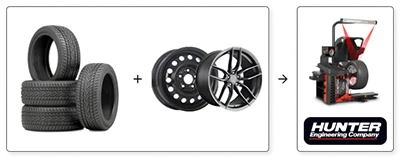How to choose the best tires for your vehicle

Whether it's the tire size, best-selling brand or season, your PMCtire expert or our search tool will help you determine what's best for your vehicle model.
To choose the right tires for your vehicle, you need to consider several factors to ensure optimum performance, safety and comfort.
Here are a few tips to guide you in choosing your future tires.
Understand your vehicle's tire specifications
Start by consulting your vehicle's owner's manual or the tire nameplate on your driver's door pillar or inside the fuel filler flap. These sources will provide information on recommended tire size, load index, speed rating and any specific requirements or recommendations from the vehicle manufacturer.
Determine your driving needs
Assess your driving habits, conditions and priorities. Consider factors such as weather conditions (rain, snow, ice), terrain (highway, off-road), average mileage and desired performance characteristics (handling, comfort, fuel economy).
Choose the good type of tire
Choose the best type of tire for your needs. The most common types are all-season tires, summer tires, winter/snow tires and performance tires. All-season tires offer a good balance of performance and versatility for a variety of conditions, while specialty tires offer enhanced performance in specific situations.
Consider performance and handling
Determine the level of performance and handling you want. Performance tires offer better grip, better handling in corners and greater responsiveness while touring or passenger tires offer a smoother, more comfortable ride.
Check tread life and manufacturer's warranty. Tread life is an estimate of tire life.
Also, consider the warranty offered by the tire manufacturer, which may vary in terms of mileage coverage or specific conditions.
Research and compare makes and models
Look for reputable tire brands that offer good quality, good performance and good customer reviews. Compare different tire models according to desired specifications and read descriptions from PMCtire experts to get an idea of performance, durability and overall satisfaction.
Budget considerations
Determine your tire budget, bearing in mind that the price of different makes and models can vary considerably. Remember that investing in top-quality tires will give you better performance, longer life and greater satisfaction.
Installing new tires contributes to greater safety on the road
New tires have a deeper tread for better traction on wet or slippery surfaces. Adequate tread depth helps the tires to keep water away from the contact patch, reducing the risk of hydroplaning and maintaining a better grip on the road. This is also what happens with winter tires: new tires guarantee better grip on the road and greater safety.
Another very important point is that, over time, tires wear out and the depth of the tread decreases. Worn tires have reduced traction, especially on wet or icy roads, increasing the risk of skidding or losing control. New tires guarantee optimum tread depth, which improves grip and handling.
New tires often offer better performance characteristics than worn tires. They offer improved responsiveness, cornering stability and braking capabilities. This enhanced performance helps drivers to control their vehicles better in a variety of driving situations, contributing to overall safety.
Tires have a limited lifespan due to factors including age, heat and exposure to the elements. As they age, the rubber can deteriorate, making them more susceptible to blowouts. New tires eliminate the problems associated with age-related degradation of rubber compounds, making them a safer and more reliable option.
The importance of prevention and inspections
When new tires are purchased, they must be inflated to the correct pressure during installation. Maintaining proper tire inflation is essential for safety and optimum performance. New tires allow you to start with the appropriate pressure and minimize the risk of under-inflation or over-inflation, which can affect handling, braking and tire life.
It's important to note that while new tires improve safety, regular tire maintenance is also vital. That includes regular inspections, tire rotation and maintaining proper inflation pressure. Driving habits and road conditions also influence overall safety. Safe driving habits, like observing speed limits, keeping a safe distance from other vehicles and adapting to weather conditions, are just as important to road safety.
Your tires have to handle a wide variety of climatic conditions: rain, high heat, snow, ice and so on. These all affect tire performance, so to make sure you stay safe you need to buy tires that will perform not only in your most common climate conditions, but also in the most extreme conditions that you will face.


